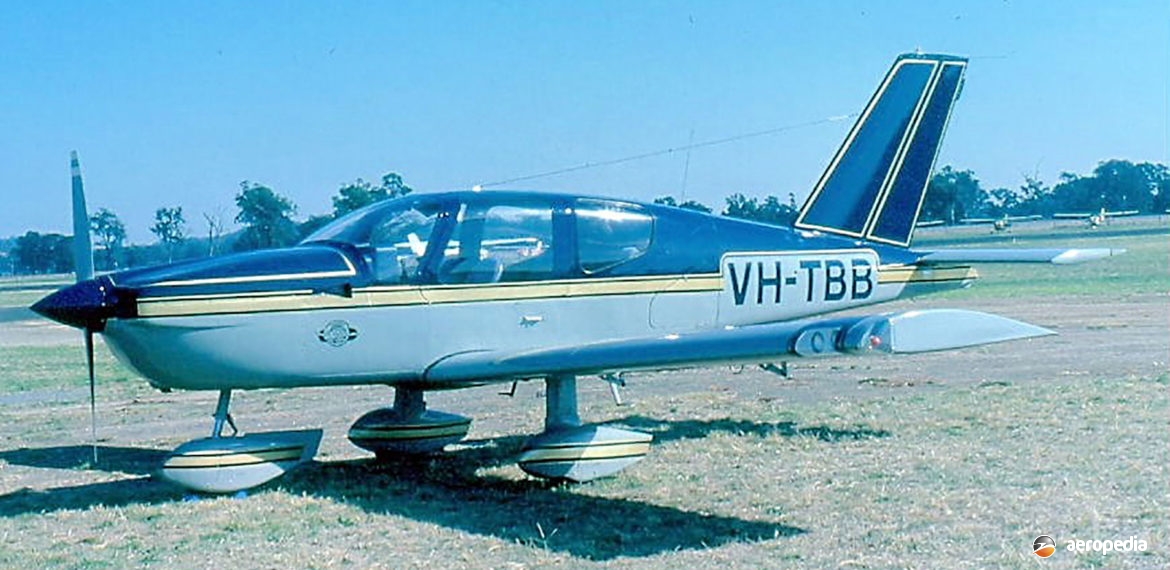Photograph:
Socata TB-9 Tampico VH-TBB (c/n 176) at Mangalore, VIC in April 1982 (David C Eyre)
Country of origin:
France
Description:
Four-seat touring and training monoplane
Power Plant:
One 119 kw (160 hp) Lycoming O-320-D2A four-cylinder horizontally-opposed air-cooled engine
Specifications:
- Wingspan: 9.76 m (32 ft 0¼ in)
- Length: 7.63 m (25 ft 0½ in)
- Height: 3.20 m (10 ft 6 in)
- Wing area: 11.90 m² (128.1 sq ft)
- Max speed: 232 km/h (144 mph)
- Cruising speed at 75% power: 225 km/h (140 mph)
- Initial rate of climb: 213 m/min (700 ft/min)
- Service ceiling: 4,300 m (14,107 ft)
- Take-off to 15 m (50 ft): 570 m (1,870 ft)
- Landing distance from 15 m (50 ft): 380 m (1,247 ft)
- Landing run: 185 m (607 ft)
- Range: 860 km (530 miles)
- Empty weight: 650 kg (1,433 lb)
- Loaded weight: 1,060 kg (2,337 lb)
History:
In 1979 Socata, the general aviation division of Aerospatiale, was continuing with development of a series of light aircraft. At this time the TB-10 was named the Tobago, and a new less powerful model became the TB-9 Tampico, the latter being aimed at the training market. This series of aircraft was of all-metal construction and, although it followed the Rallye on the production line, which had originated with Morane Saulnier as the MS-880 and had been produced for some 20 years, the new series of aircraft had no direct relationship as far as construction and design were concerned.
Two variants of the TB-9 were available, the Tampico FB with a 119 kw (160 hp) Avco Lycoming O-320-D2A engine with a fixed-pitch Sensenich propeller; and the Tampico CS with the same engine but fitted with a Hartzell constant-speed propeller.
The Tampico, like the Tobago, used composite construction in some components such as the engine cowling, wheel fairings, doors and rear decking. The wing was of rectangular planform and had an RA 16-3C3 section developed by Aerospatiale, electrically operated single-slotted flaps which occupied 30 per cent of the wingspan, and had a maximum deflection of 32 degrees. The aerodynamically-balanced ailerons had a maximum of 15 degrees up and down. The main wheels had disc brakes operated by the rudder bar, and the nosewheel was steerable. Dual control was optional. Structurally identical to the Tobago, the Tampico had a lower-powered engine and a fixed-pitch propeller instead of a constant speed unit. Whereas the TB-10 could carry four or five occupants, the fifth being on a rear bench seat, the Tampico could only carry four.
Only a small number of Tampicos came to this region, most operators choosing the more powerful TB-10 series. The first aircraft, VH-TBB² (c/n 176), was registered on 9 June 1981 and was exported to New Zealand, becoming ZK-TGW on 18 January 1983 and initially being based at Wanaka. A further TB-9 was imported to Australia from the Solomon Islands, becoming VH-SXE² (c/n 1619 – ex H4-CWA [ntu]) based in Queensland, followed by VH-JTL (c/n 218) registered on 25 January 1985 which was exported to the United States on 5 July 2002 as N5341M.

